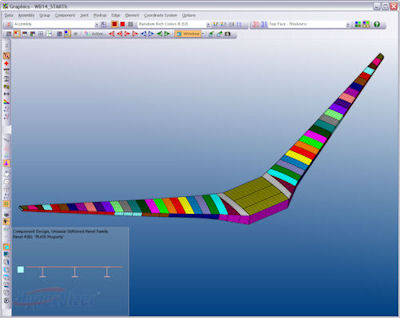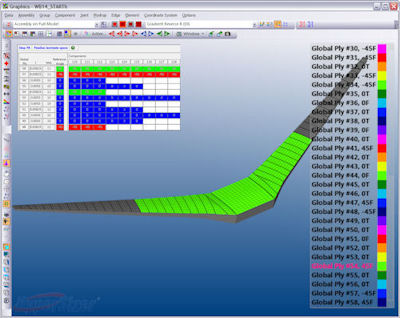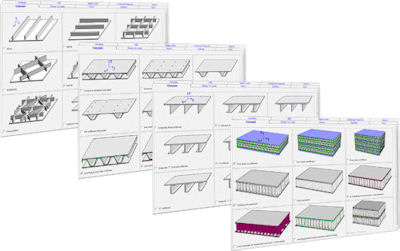Posted on 7/3/2013
Source: Digital Engineering
Collier Research Corp. (Hampton, VA) says that its newly released HyperSizer version 6.4.5 composite structural analysis and optimization software not only runs much faster than earlier versions but that it’s now based on a reconfigured core technology with built-in “intelligence” that produces more accurate answers with less user input.
 This HyperSizer screen shots show wingbox FEM structural sizing components being defined. The colors represent stiffened skin panel bays. Image courtesy of Collier Research Corp. |
HyperSizer provides design, analysis, and optimization capabilities for both composite and metallic structures, according to the company. Intended for use throughout the process from preliminary design to final analysis, HyperSizer, says Collier Research, helps engineers quantify critical failure modes, reduce structural weight, and sequence composite laminates for fabrication to avoid unexpected design problems and weight growth as the design matures. HyperSizer v6.4.5 is said to offer “a completely different approach that will make the general engineer’s job easier while providing reliable results much faster than before.”
“The software requires less input from the user to set up an optimization of, say, an aerospace structural component or a wind turbine blade,” explained Collier Research president and founder Craig Collier in a press statement. “It looks at load magnitude and from there is able to configure itself automatically to do a pre-setup of the proper optimization parameters. This gives the engineer consistent, reliable results regardless of their expertise level.”
 An example of updating FEM and CATIA with an optimized design. Track and View Laminate Global Ply Coverage capabilities are shown. Image courtesy of Collier Research Corp. |
The analysis engine of v6.4.5, says the company, takes advantage of HPC (high-performance computing) technology to speed up runs by 200 to 400% across the board. Optional quick sizing and variable tuning capabilities are said to be as much as 1,000 times faster.
The new version now also supports nonlinear and dynamic load stepping Abaqus and Nastran FEA solutions. For the wind industry, weight/cost optimization has also been added to enable engineers to include the effects of material choices on tools, labor, facilities, etc., when studying tradeoffs between carbon fiber and fiberglass.
 HyperSizer offers users the ability to choose from more than 50 panel and beam concepts. Image courtesy of Collier Research Corp. |
Version 6.4.5 also offers a new FEA Load Extraction Method called “Peak Element” for projects with many load cases. Peak Element is described as filtering out from the hundreds or thousands of the critical load cases based on their magnitudes and not on any failure mode analyses. Other enhancements include ANSYS components now import as HyperSizer assemblies; export of CATIA “thickness law” and “virtual ply” data for direct import into CATIA; cross-section visualization and property calculations; and support for fatigue-only load cases.
“Many industries use composites ]and] for many engineers, a working knowledge of composite design and optimization will be an essential requirement for future product development,” says Collier. “If you really want organizations to be successful implementing composites, we’re going to have to start making the process less complicated. This latest version of HyperSizer software is an important step in that direction.”
